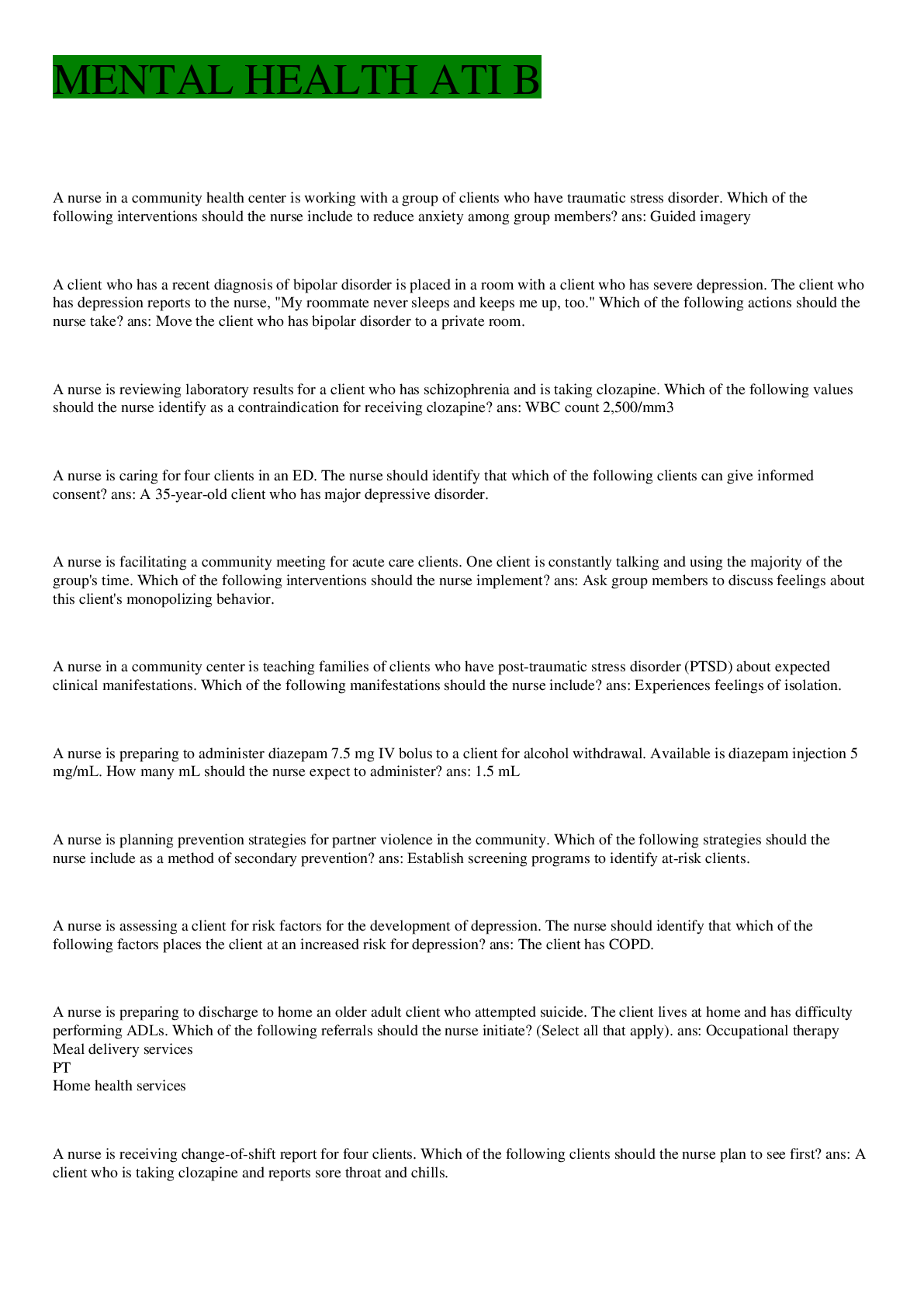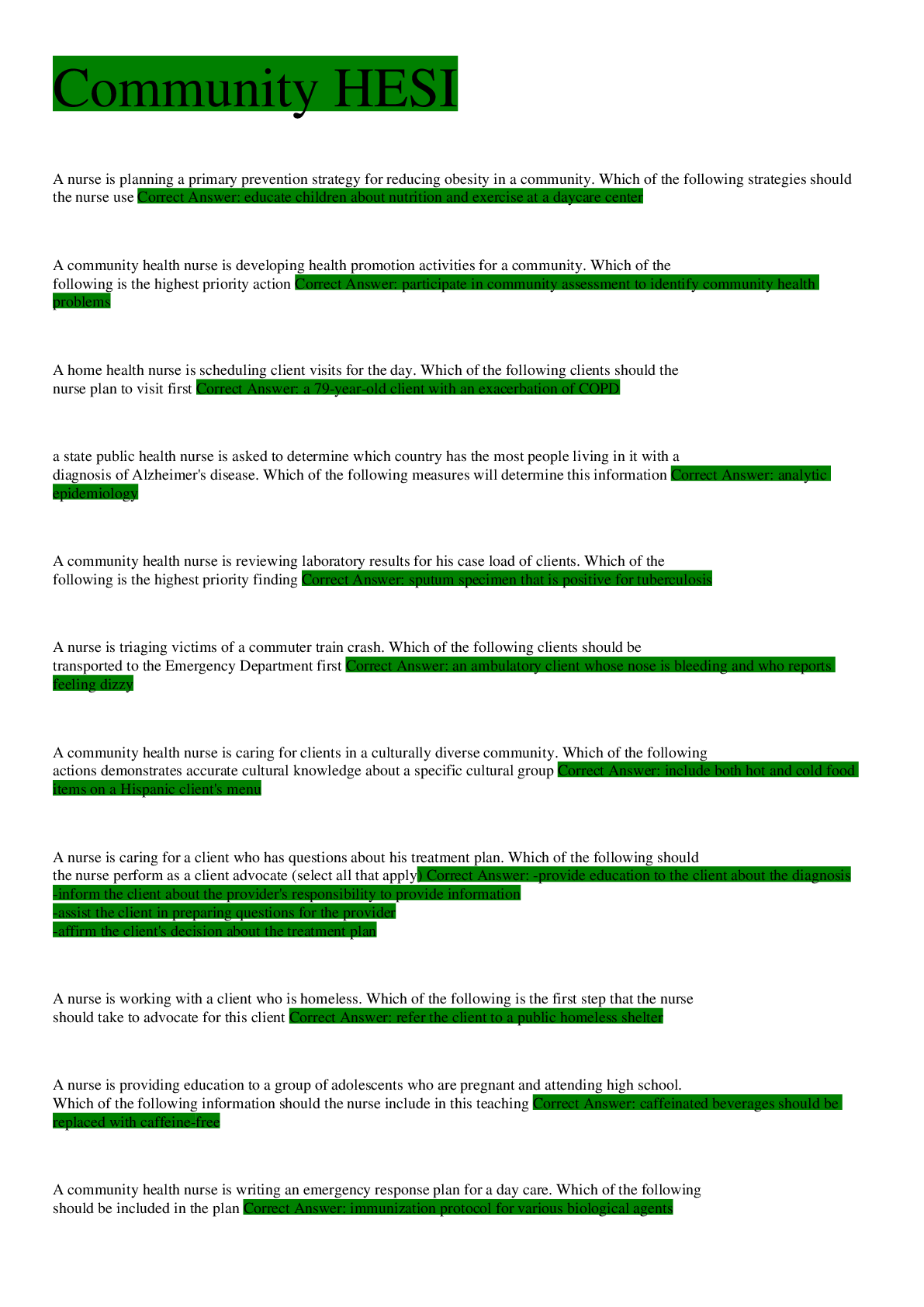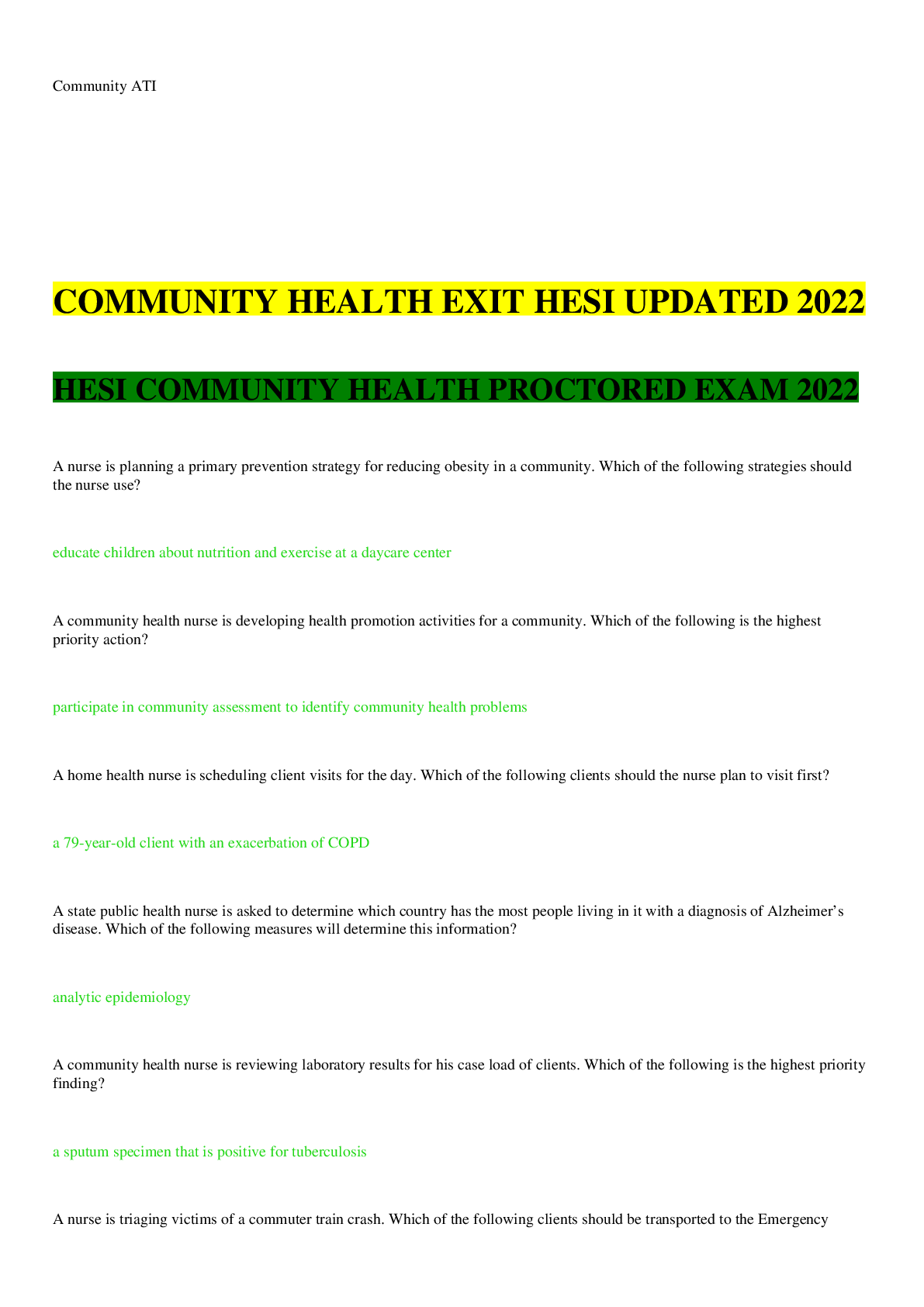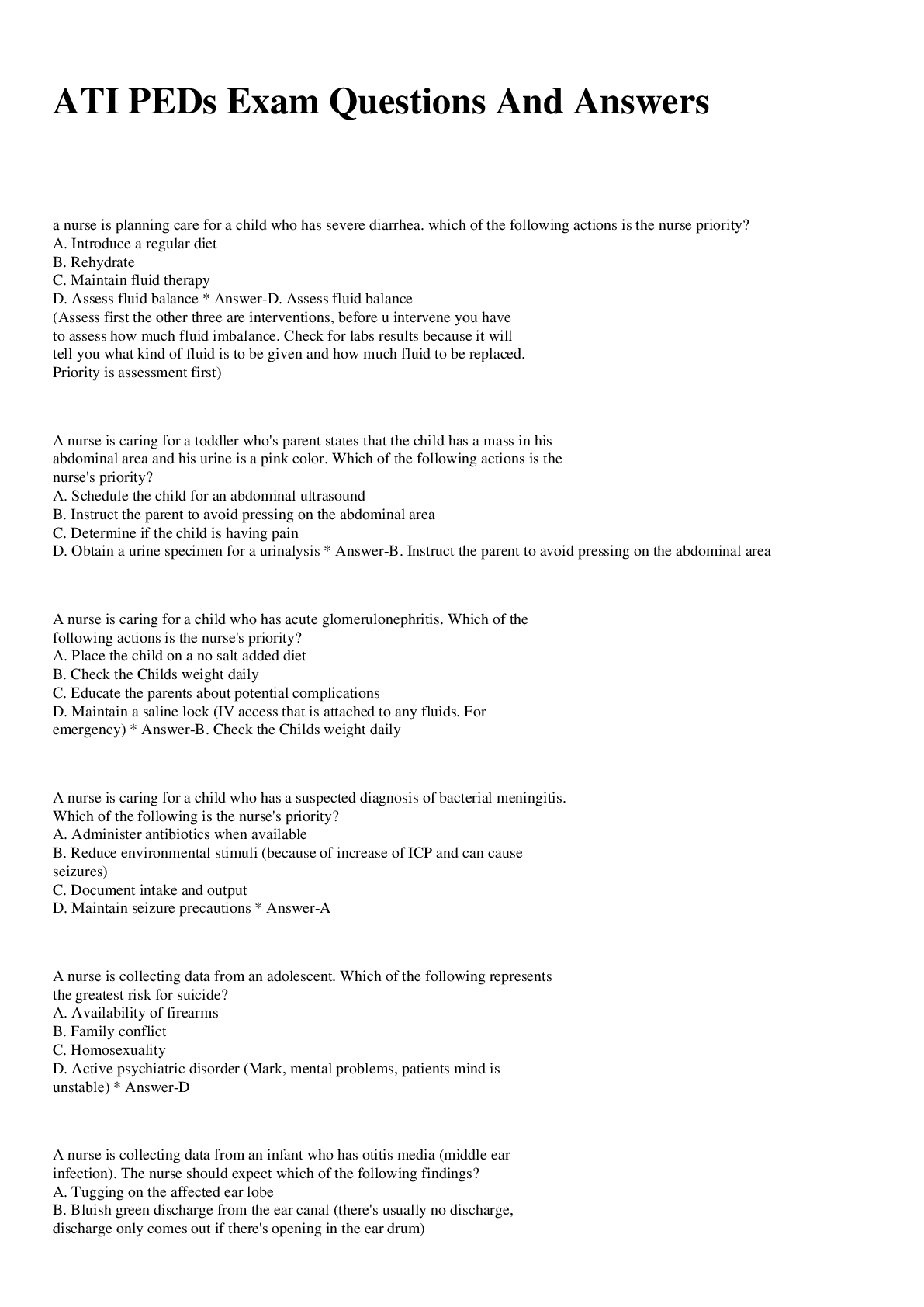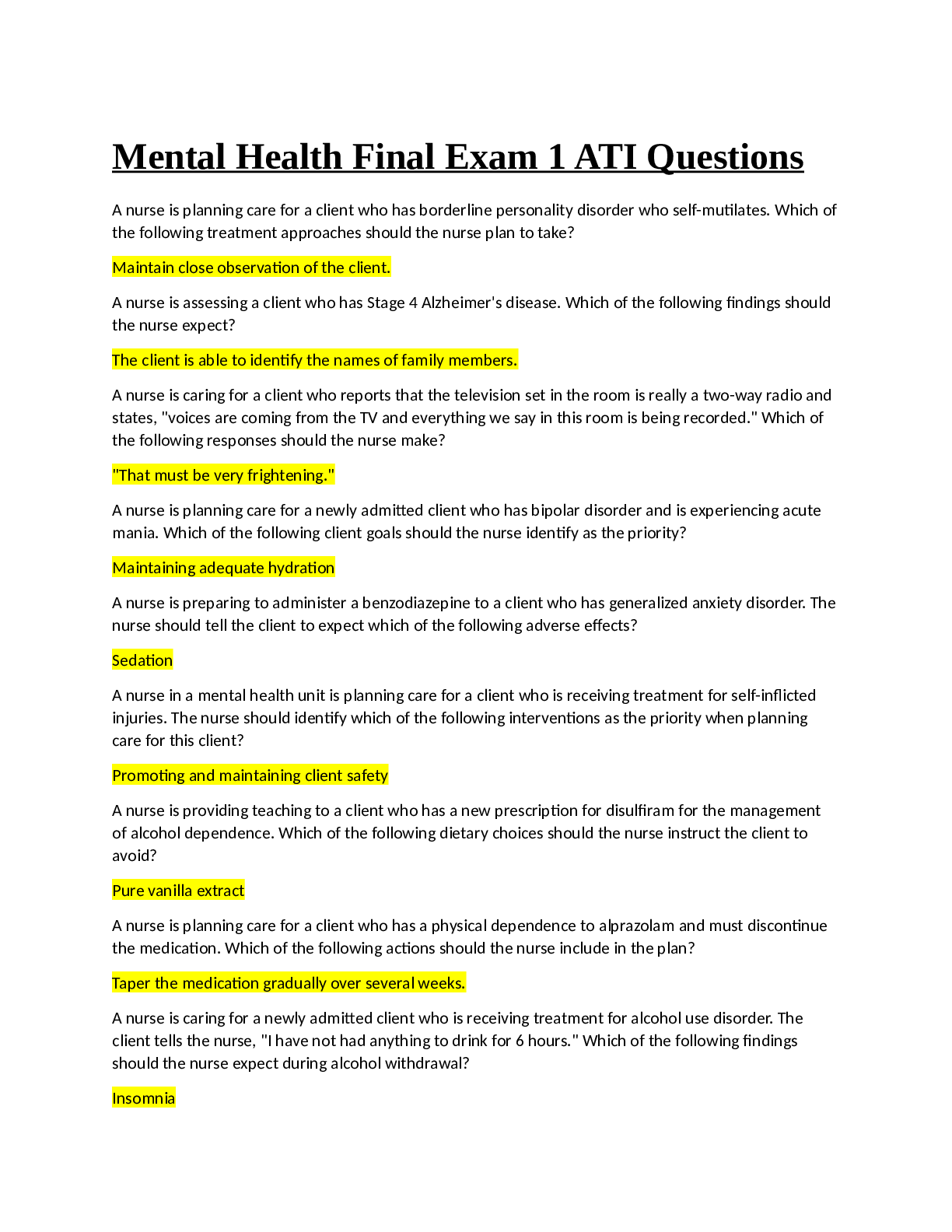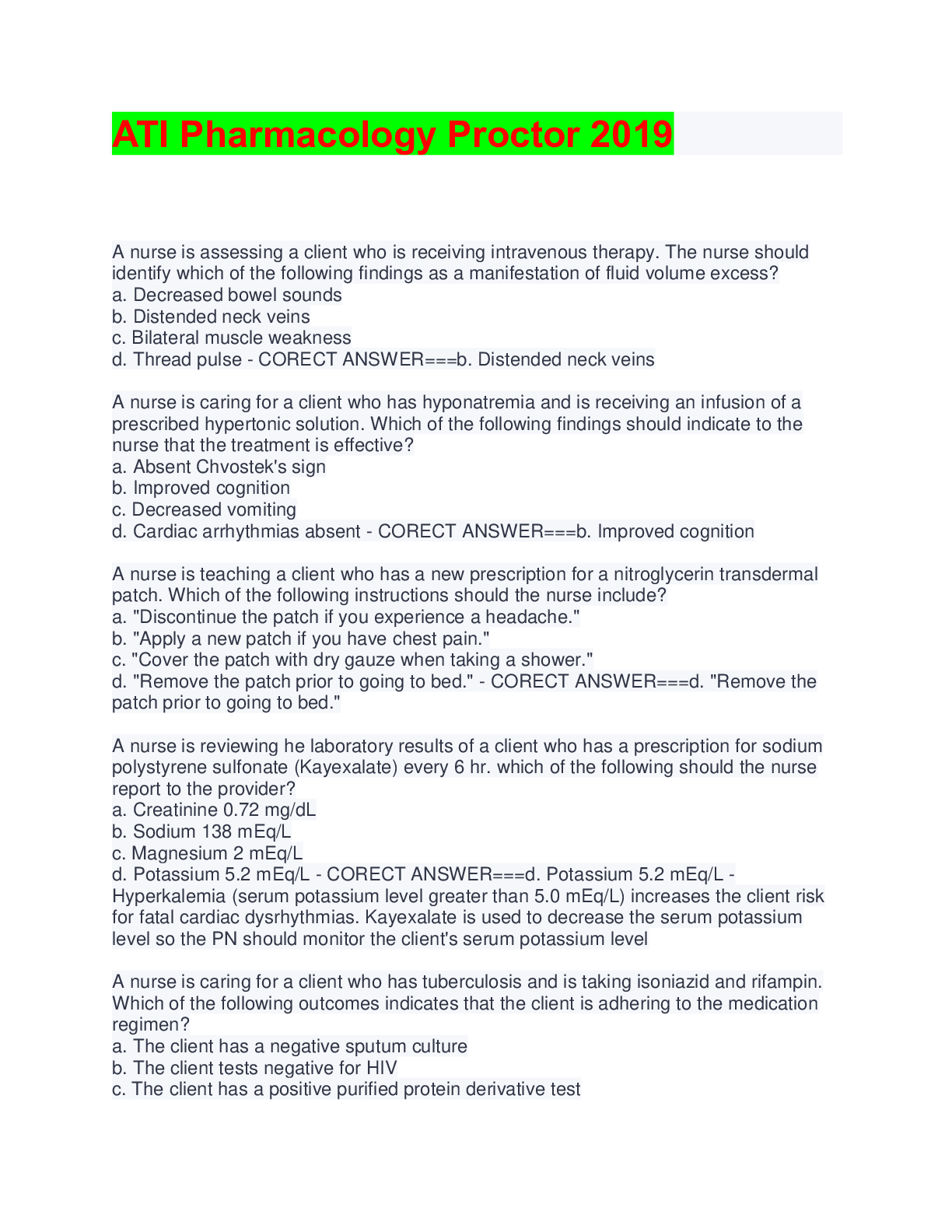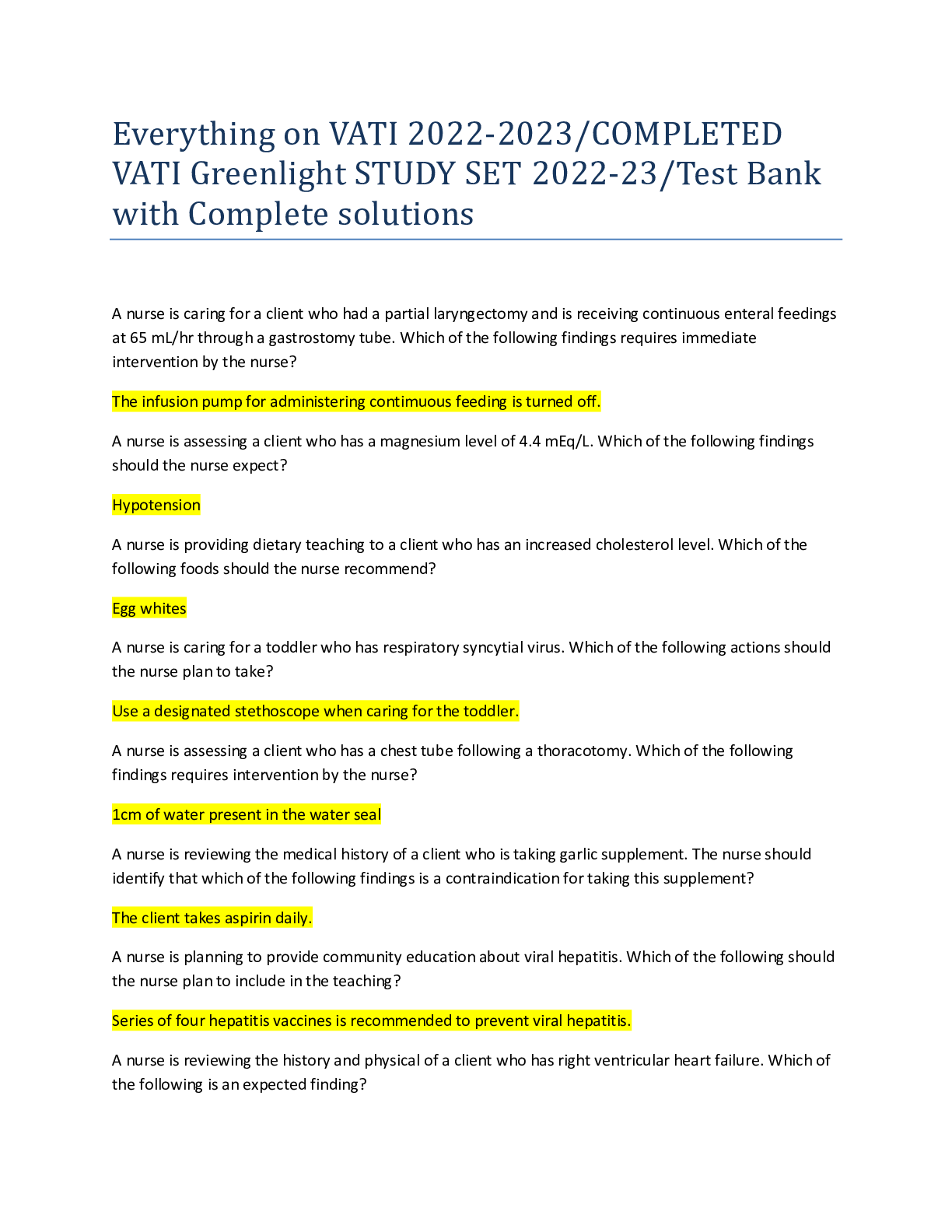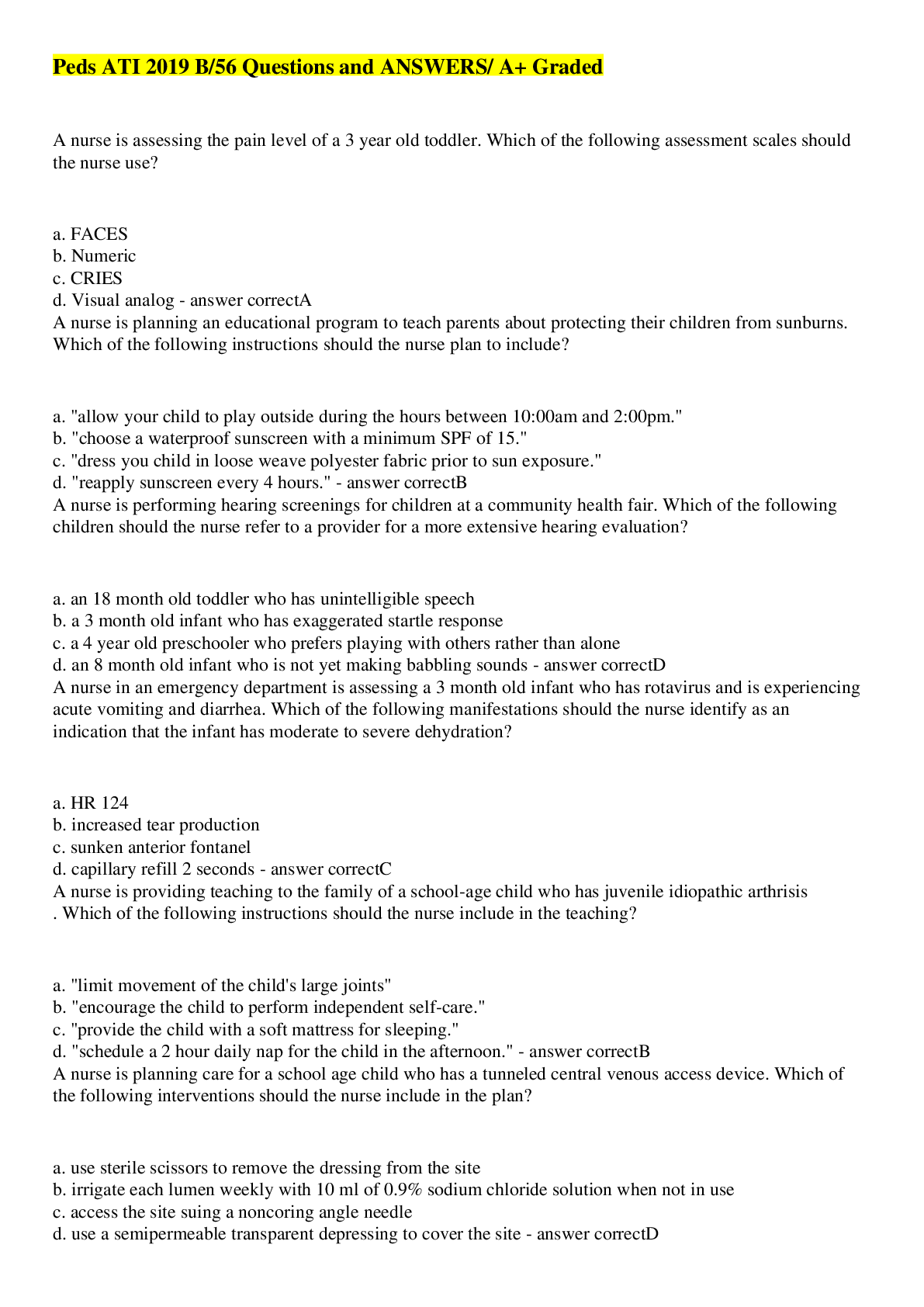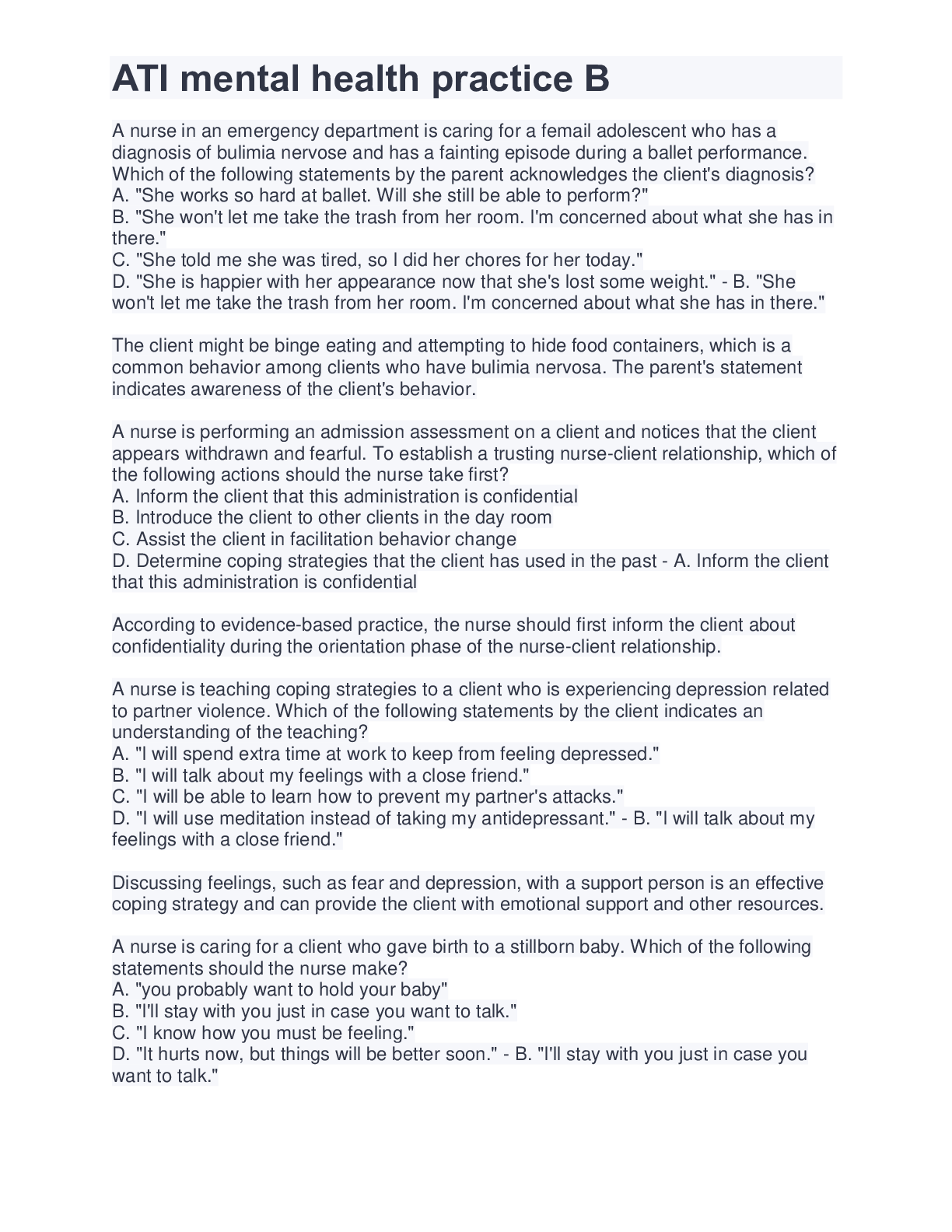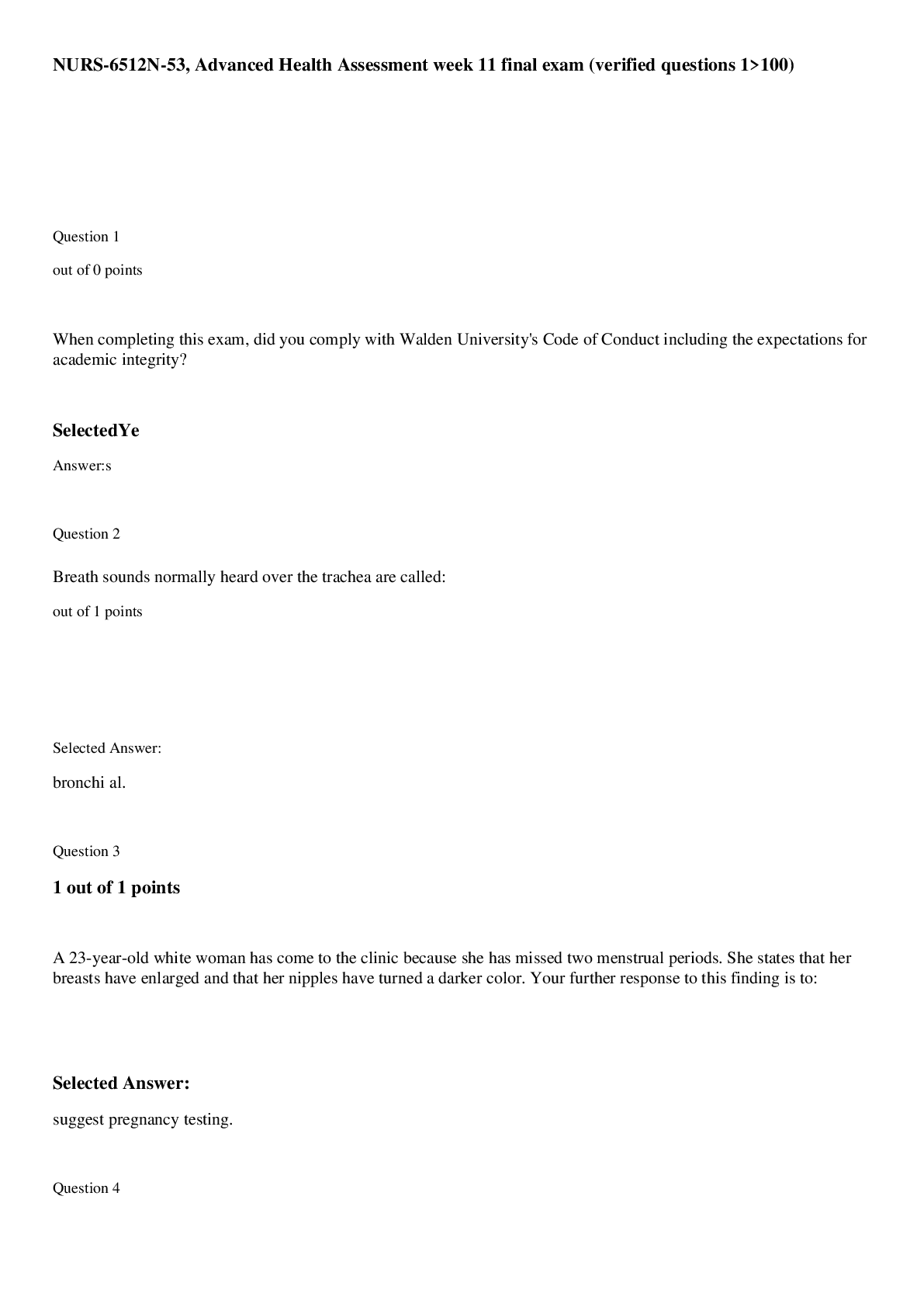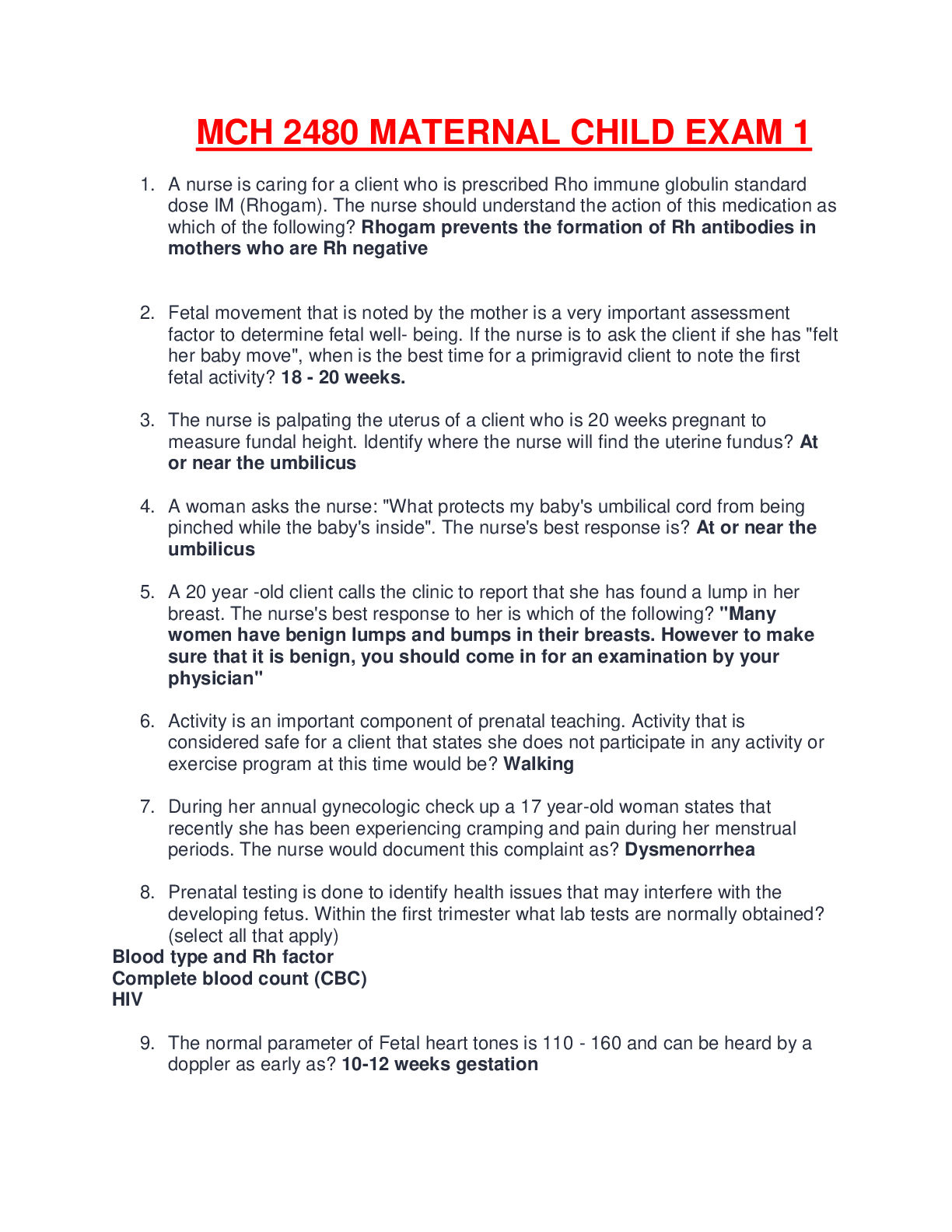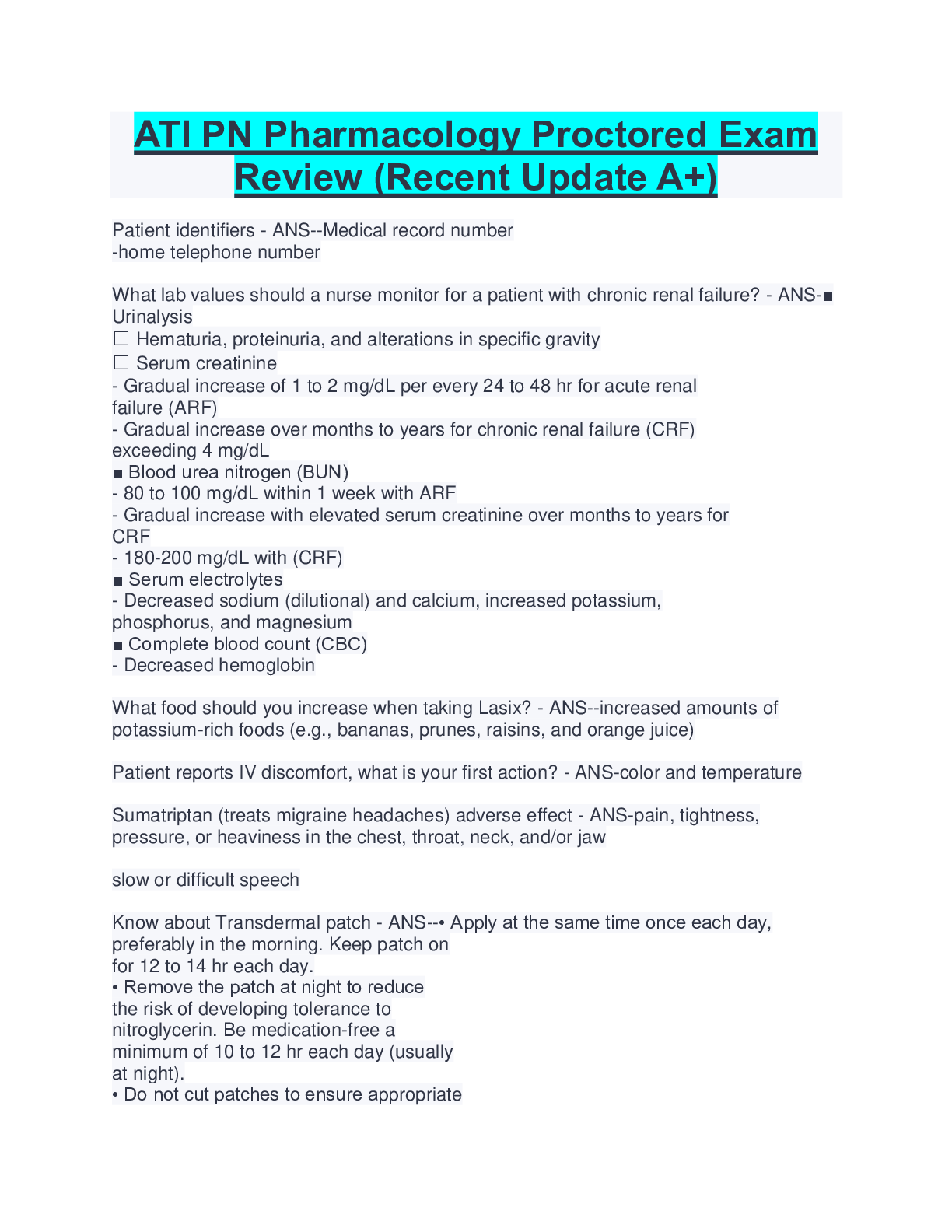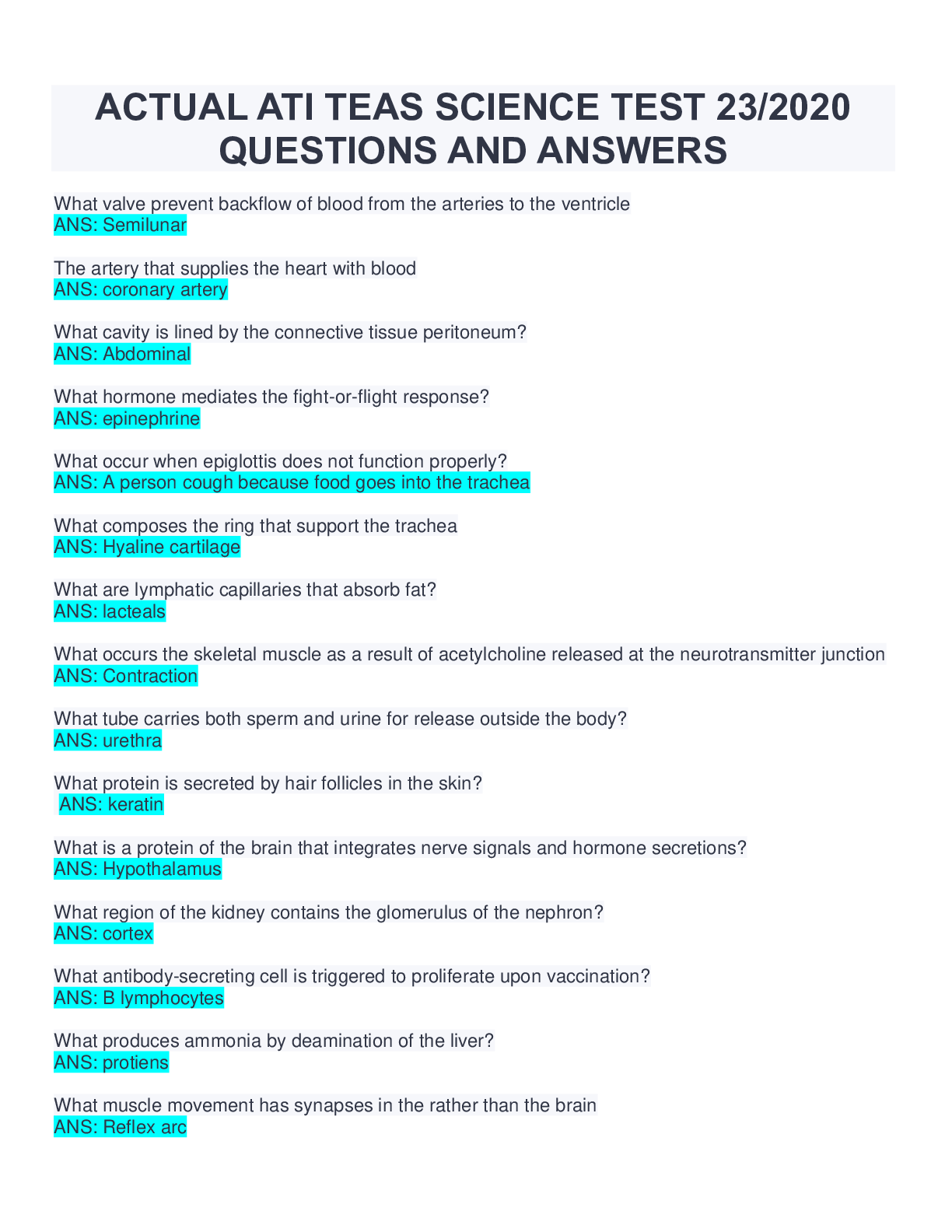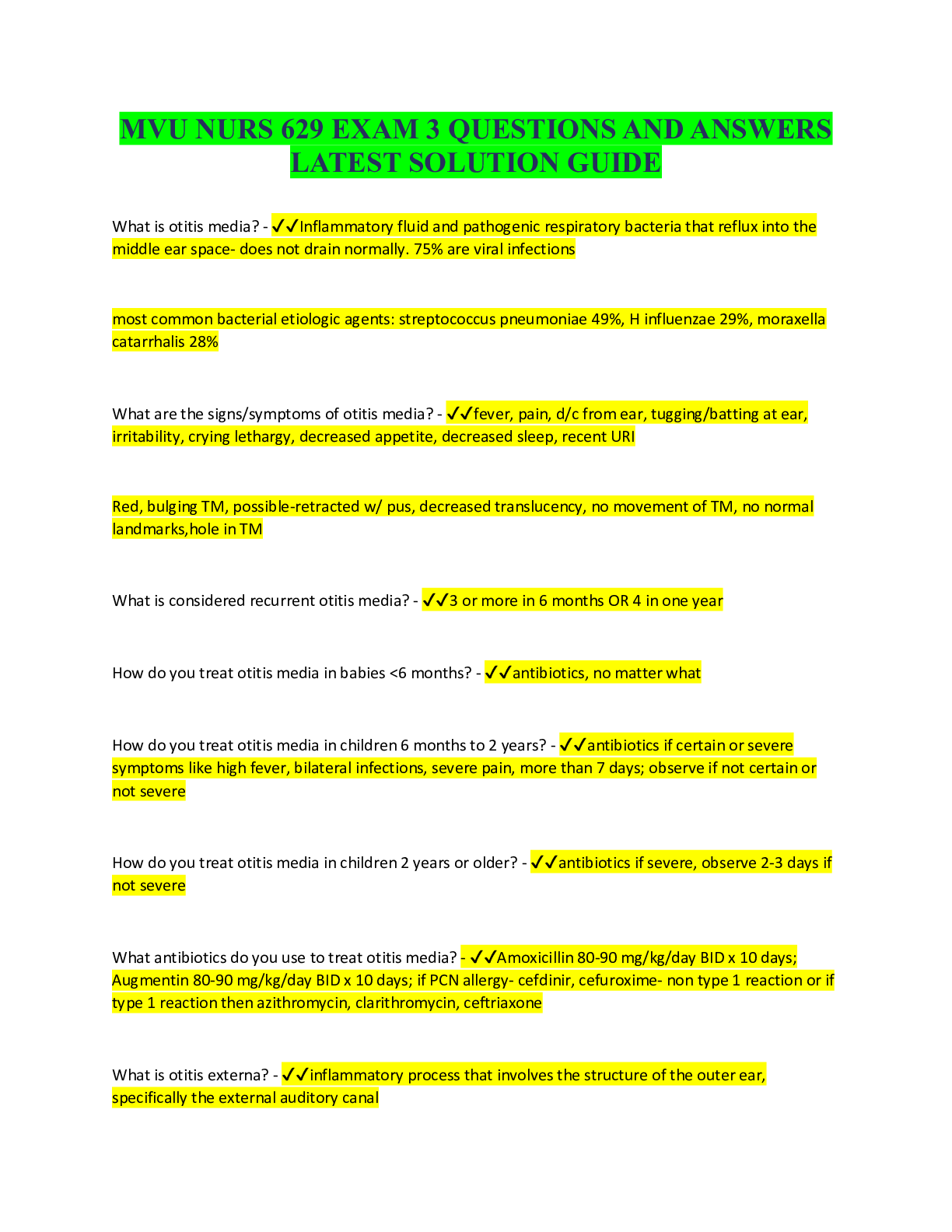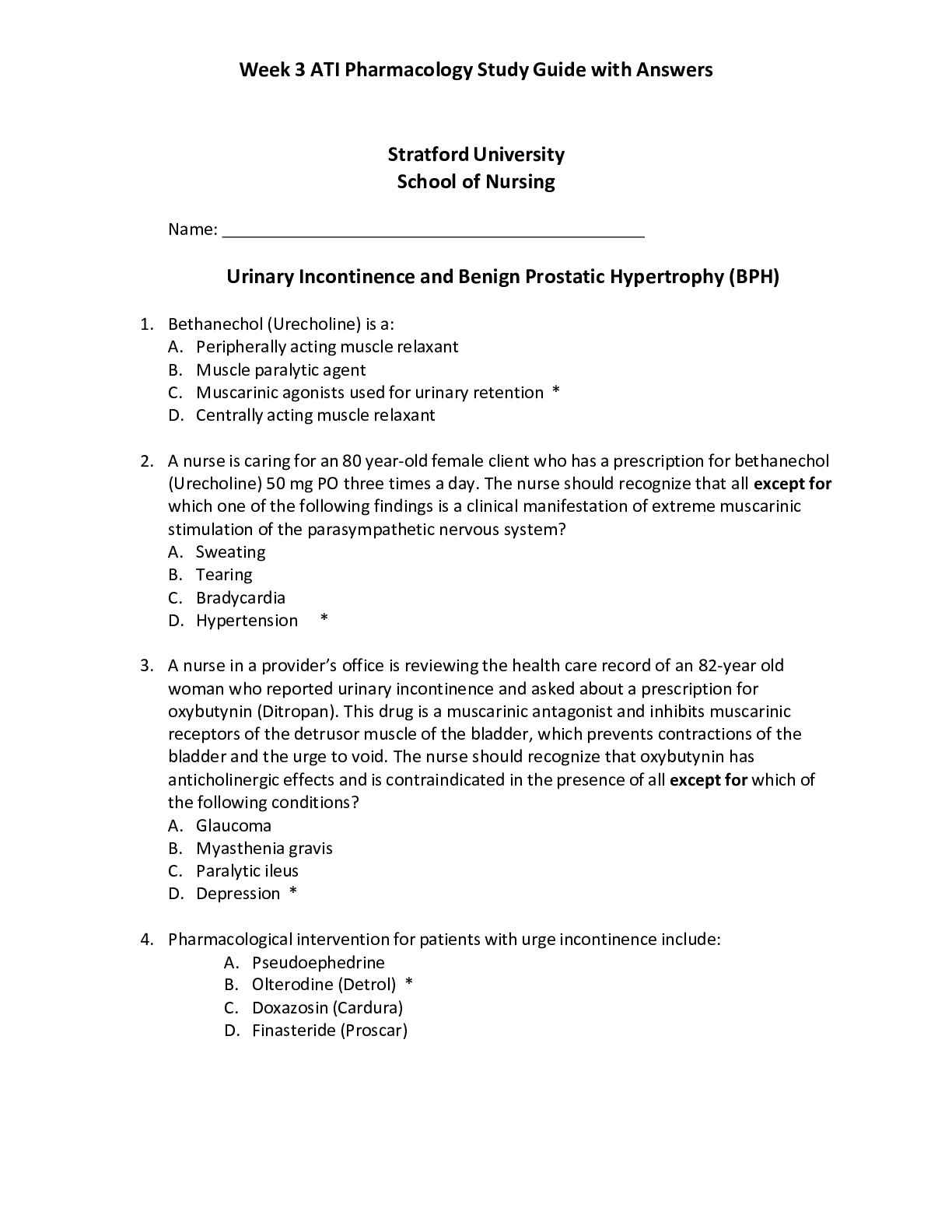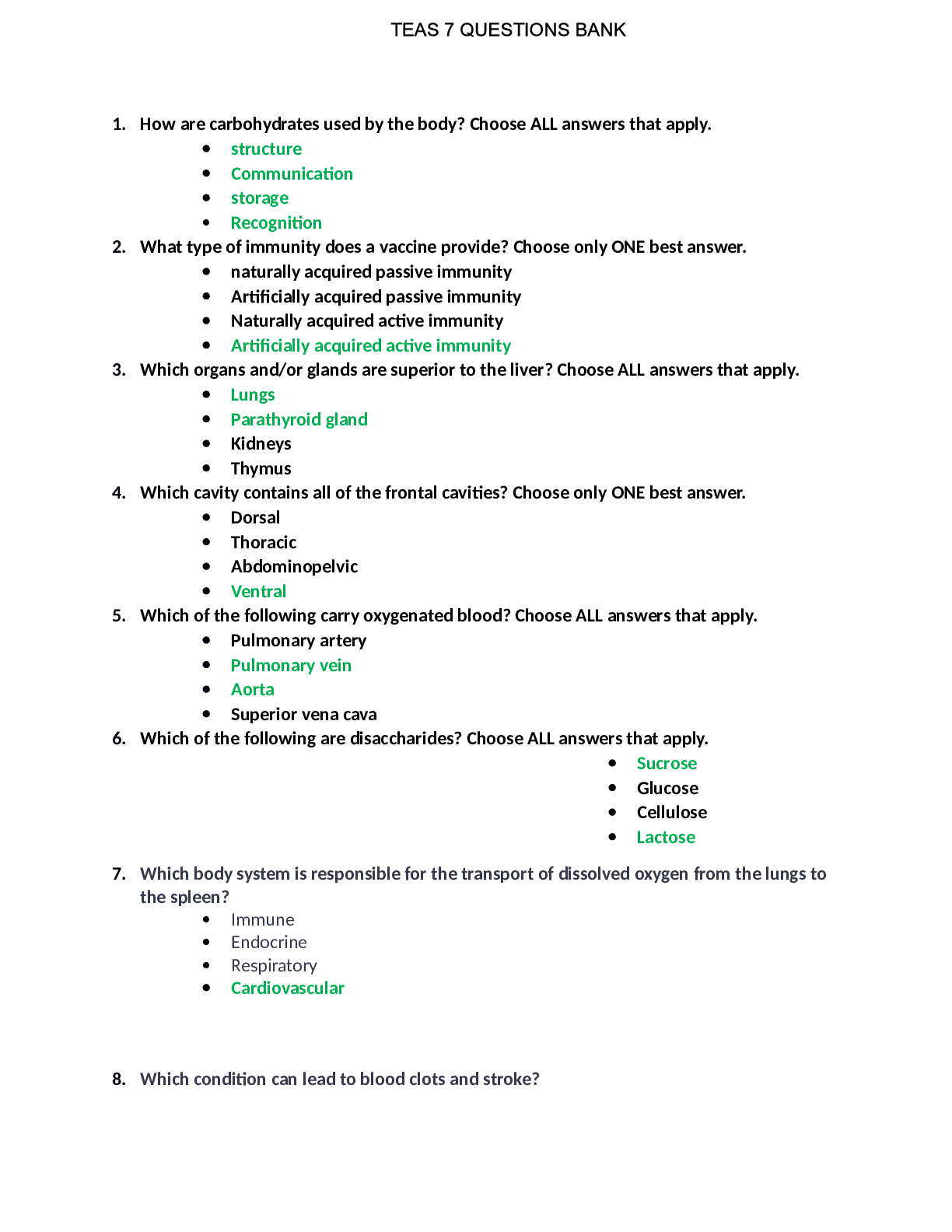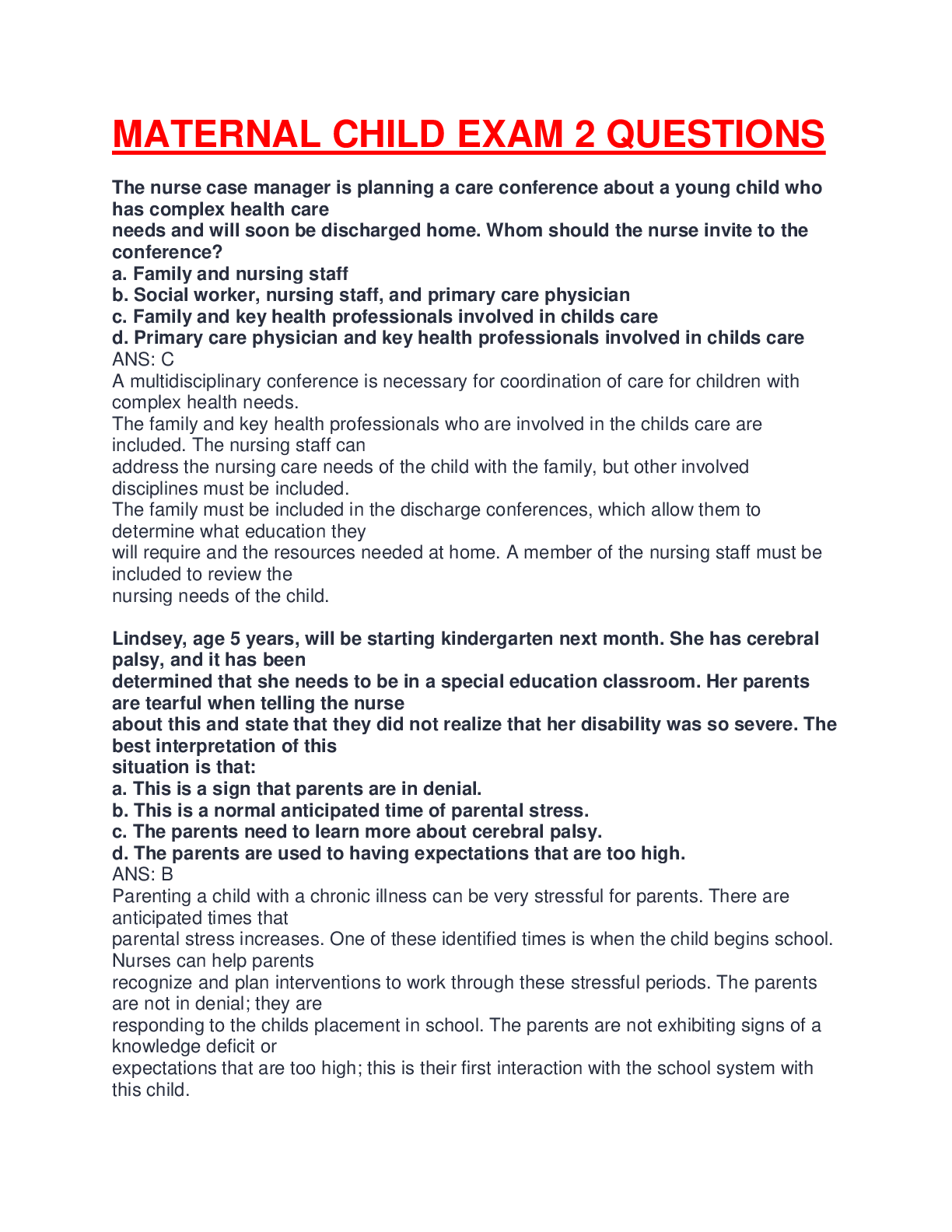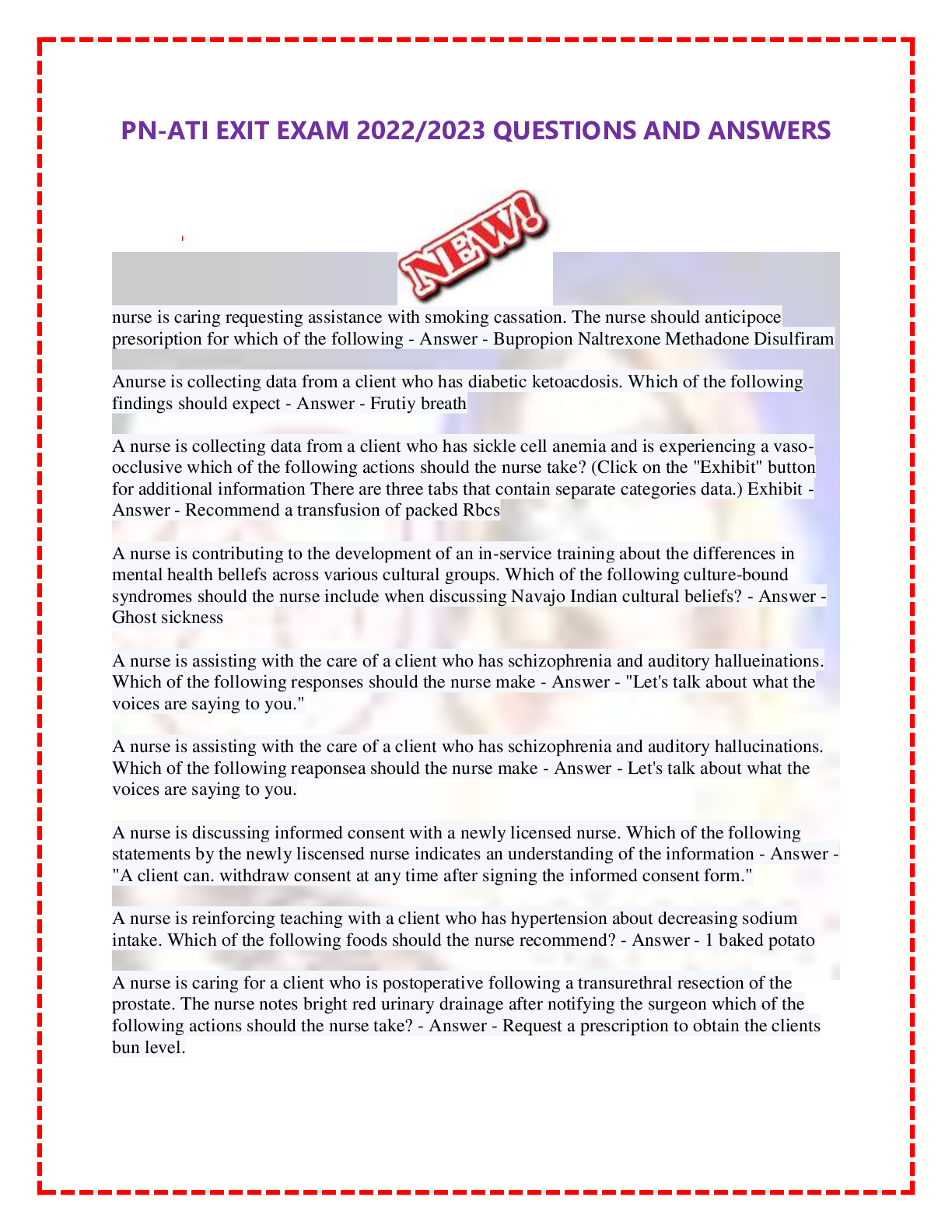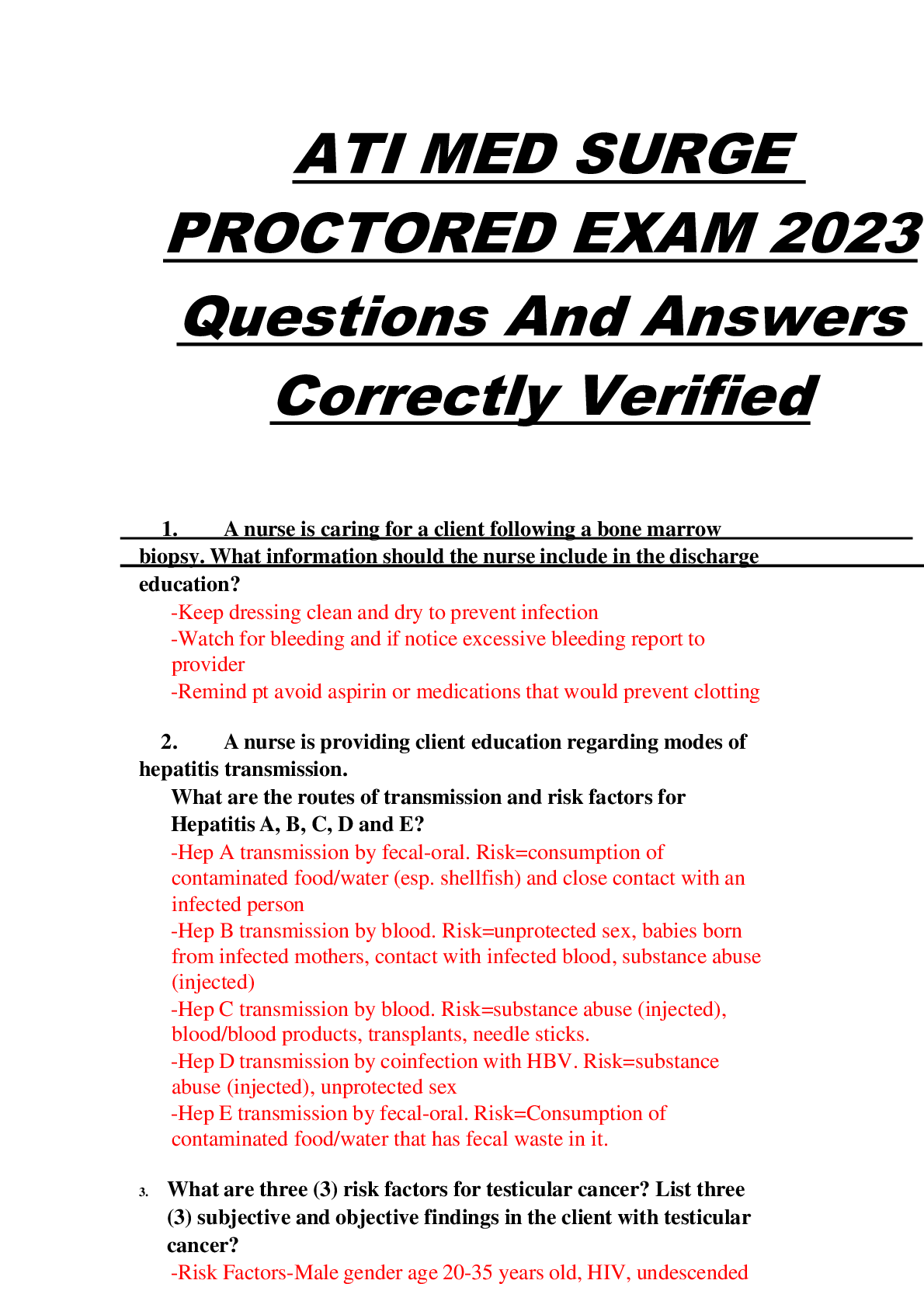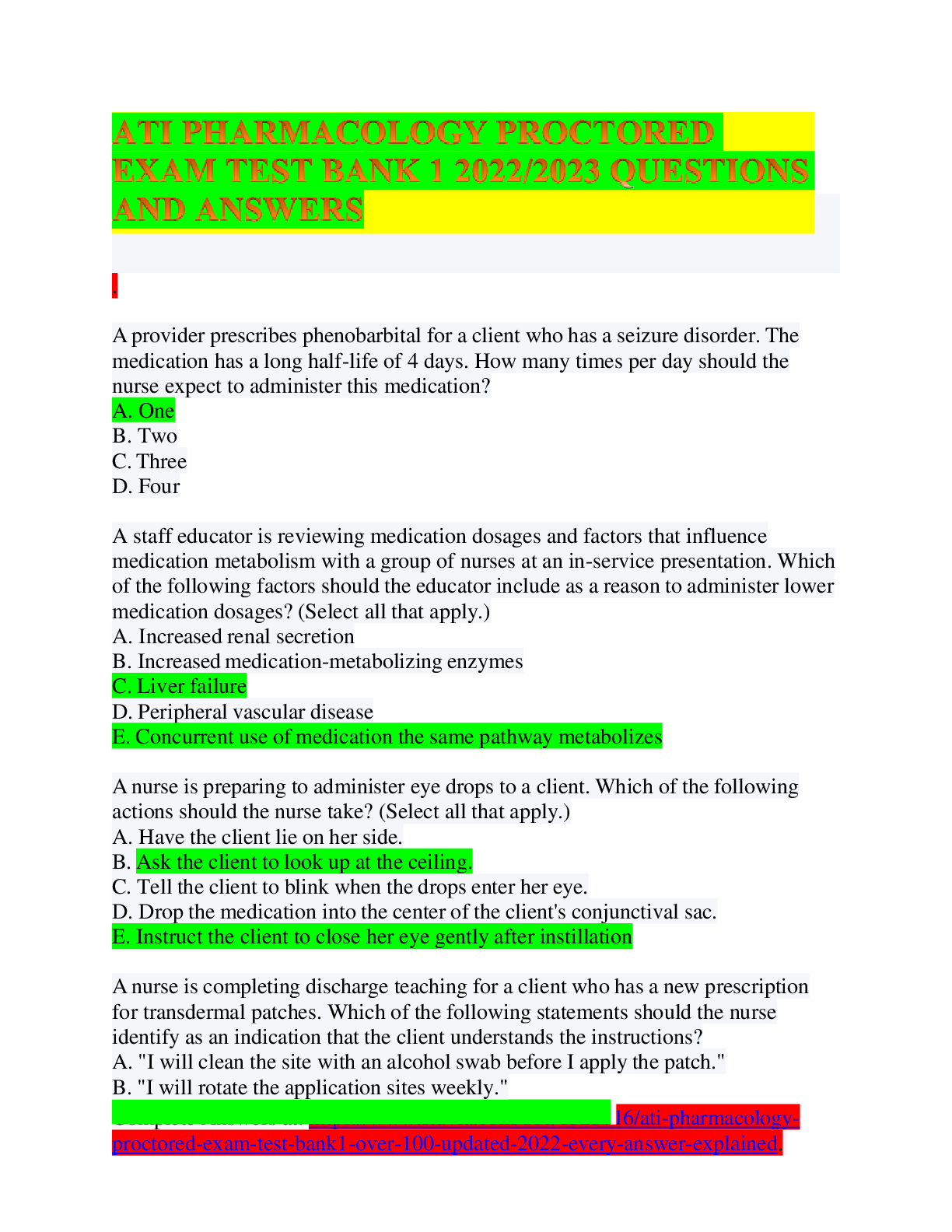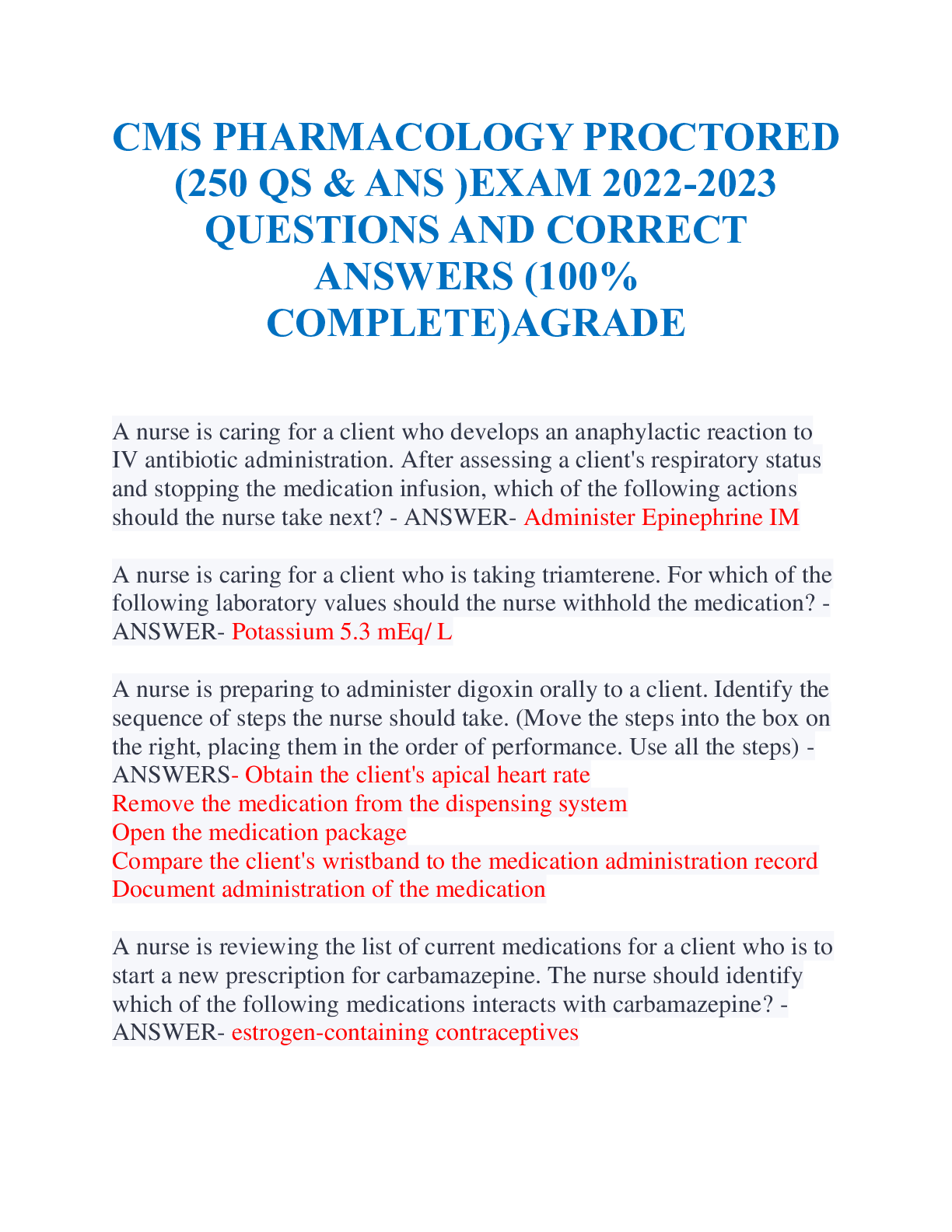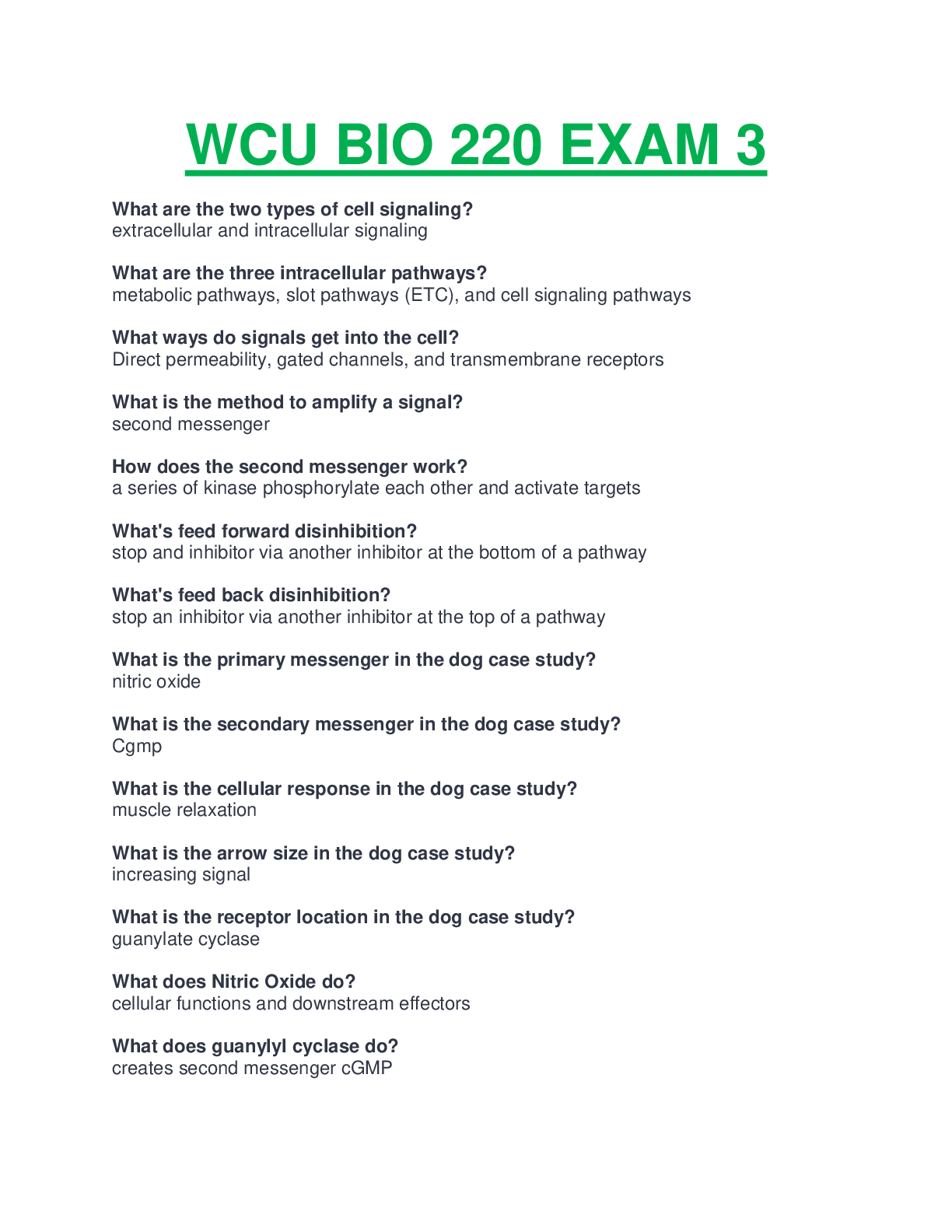NURSING 2633 Maternal Child Exam 3 Questions and Answers- Rasmussen College
Document Content and Description Below
Maternal Child Exam 3 A labor and delivery nurse explains to the student that the most common complication following a spinal anesthesia block is which of the following? A. Fetal depression B. ... Hematoma C. Maternal hypotension D. Severe pruritus ans: C The most common complication seen with the use of spinal anesthesia blocks is maternal hypotension. The other options are less common complications. A laboring woman has the nursing diagnosis of fear related to incomplete childbirth education. What assessment would best indicate that actions to decrease fear have been successful? A. Better knowledge B. Chooses analgesia C. Decreased pain D. Increased pulse ans: C Anxiety and fear stimulate the release of catecholamines and heighten the sensation of pain. Decreased fear leads to relaxation and less pain. The other options do not show decreased fear. A new nurse is working with a patient undergoing an induction of labor. What action by the new nurse would prompt the preceptor to intervene? A. Assesses contractions every 5 minutes in the second stage of labor B. Calculates and charts the maternal total urine output every 4 hours C. Documents an IV intake of 1,500 mL in 8 hours D. Records the maternal vital signs a minimum of every 60 minutes ans: C During an induction of labor, the IV fluid intake should not exceed 1,000 mL in 8 hours to prevent fluid overload after the placenta is delivered. If the new nurse has documented a larger amount, the preceptor needs to intervene. The other options show proper care of this patient. A nulliparous woman has been admitted to the labor and birth unit. Her Bishop score is 4. What medication does the nurse plan to administer? A. Betamethasone (Celestone) B. Hydromorphone (Dilaudid) C. Misoprostol (Cytotec) D. Oxytocin (Pitocin) ans: C The Bishop score is a rating system used to determine the level of cervical inducibility. Labor induction is more likely to be successful with a higher score (9 or more for nulliparous women; 5 for multiparous women). This woman's cervix is not favorable for induction, so a cervical ripening agent should be used. Cytotec is one such agent. Betamethasone is used to improve fetal lung maturity. Hydromorphone is a pain medication. Oxytocin would be used to augment labor once the cervix is favorable. A nurse has administered dinoprostone gel (Prepidil) to a nulliparous woman whose Bishop score is 5. Fifteen minutes later the patient complains of intense itching, vaginal burning, and shortness of breath. What medication does the nurse anticipate giving? A. Epinephrine (Adrenalin) B. Hydromorphone (Dilaudid) C. Misoprostol (Cytotec) D. Terbutaline (no brand name) ans: D In case of adverse reactions to dinoprostone, the nurse will administer terbutaline, 0.25 mg intravenously or subcutaneously. The other medications are not indicated. A nurse has instructed a woman on the procedure for nipple rolling. What action by the patient demonstrates good understanding of the teaching? A. Pinches and pulls the nipples on alternating sides B. Rolls both nipples together for 10 minutes C. Rolls one nipple at a time during a contraction D. Rolls one nipple at a time through her clothing ans: D Nipple rolling can stimulate uterine contractions after labor has begun. The technique is used when labor is not progressing satisfactorily. The nurse instructs the patient to roll one nipple at a time for 10 minutes through her clothing. Then she should switch to the other side. The woman should rest during contractions. A nurse is assisting with a forceps delivery. After the forceps are applied, the nurse notes fetal bradycardia. What action by the nurse takes priority? A. Assess the fetal heart rate in 5 minutes. B. Document the findings in the chart. C. Inform the health-care provider immediately. D. Turn the woman on her left side. ans: C When the forceps are applied, umbilical cord compression can occur. Compression of the cord causes a decrease in the fetal heart rate. The nurse should immediately inform the provider so that the pressure can be released. The nurse is responsible for documenting the fetal heart rate before and immediately after forceps application, but relieving the pressure on the umbilical cord takes priority. The nurse should not wait 5 minutes for another assessment, nor should the nurse turn the patient on her side as a first action. A nurse is caring for a patient who had a laminaria tent inserted 6 hours ago. What action by the nurse is most appropriate? A. Assess and record maternal temperature. B. Document fetal and maternal heart rate. C. Perform an amniotic membrane stripping. D. Remove the laminaria tent and assess cervical dilation. ans: D A laminaria tent is a hydroscopic cervical dilator made of seaweed, which swells as it absorbs moisture. Hydroscopic dilators remain in place for 6 to 12 hours, after which time they are removed and the woman is assessed for cervical dilation. The other interventions are not specific to this type of dilator. A nurse is caring for a patient with abruptio placentae. What assessment findings would indicate that the woman is hemodynamically stable? A. Fetal heart rate: 108 beats/minute B. Hematocrit: 33% C. Oxygen saturation: 90% D. Urine output: 20 mL/hour ans: B Hemorrhage is a significant possibility with placental abruption. A hematocrit less than 30% is indicative of maternal hemodynamic stability; the presence of fetal bradycardia, maternal hypoxia, and urine output less than 30 mL/hour are indicative of an unstable state. A nurse is caring for a pregnant woman scheduled to have an epidural block. The nurse reviews the woman's admission laboratory results and finds the following: white blood count (WBC) 6,500/ mm3, hemoglobin 14 mg/dL, hematocrit 38%, platelet count 98,000, and international normalized ratio (INR) 4.2. What action by the nurse is best? A. Document the findings in the woman's chart. B. Ensure a signed consent form is in the chart. C. Notify the health-care provider immediately. D. Start a peripheral IV of normal saline (NS). ans: C Contraindications to spinal/epidural blocks include maternal refusal, local or systemic infection, coagulopathies, actual or anticipated maternal hemorrhage, allergy to a specific agent being used, or lack of trained staff. This woman's platelet count is low and her INR is high, leading to concern about coagulopathies. The nurse should notify the health-care provider immediately. Documentation should always be thorough, but further action is needed. A signed consent form should be in the chart for an invasive procedure; however, this is not the priority at this point. An IV will probably be needed prior to delivery (depending on institutional protocol), but, again, this is not the priority in the setting of a patient with abnormal laboratory results. A nurse is caring for a pregnant woman with diabetes mellitus. What assessment finding demonstrates that the patient has successfully met an important goal during pregnancy? A. Blood glucose consistently < 130 mg/dL B. Electrolyte levels remaining within normal limits C. Fetal weight > 4,500 g at birth D. Pregnancy weight gain of no more than 20 lb ans: A Women with diabetes should strive to maintain their blood glucose readings within normal parameters during pregnancy. Poor glycemic control contributes to fetal macrosomia (fetal weight > 500 g) and other complications. Weight gain should not be restricted to 20 lb, and electrolyte readings are not related to a major goal for this woman. A nurse is caring for a woman who gave birth to a term infant an hour ago. The chart notes that the baby was born after demonstrating a positive turtle sign. What assessment finding by the nurse warrants immediate action? A. Lochia rubra is noted an hour after birth. B. Maternal blood pressure is 90/42 mm Hg. C. Maternal heart rate is 68 beats/minute. D. Patient saturates one perineal pad in 2 hours. ans: B A turtle sign describes a situation where the fetal head retracts during contractions after crowning. This is a clinical indicator of possible shoulder dystocia. Maternal complications of shoulder dystocia include hemorrhage and soft tissue trauma. A blood pressure as low as this woman's blood pressure measurement could be an indicator of hemorrhage, and the nurse needs to assess the woman further. The finding of lochia rubra 1 hour after birth is normal, as is a maternal heart rate of 68 beats/ minute. The finding of one saturated perineal pad within 2 hours is also normal. A nurse is caring for a woman who has an order for a high-dose oxytocin (Pitocin) regimen to stimulate uterine contractions. Which of the following actions are appropriate for the nurse to take? (Select all that apply.) A. Assess frequently for uterine tachysystole. B. Increase the infusion every 30 minutes as needed. C. Place to woman prone to prevent dizziness. D. Start the infusion at 2 mU/minute. E. Use an electronic infusion device. ans: A, B, E Oxytocin must be administered safely. The high-dose regimen begins with 4 mU/minute and is increased by the same amount every 30 minutes as needed. Uterine tachysystole can occur and the nurse must assess carefully for the development of this situation. The woman is placed sitting upright or in a side-lying position. Oxytocin should always be infused via an electronic infusion device. A nurse is caring for a woman who is going to have an epidural block. The physician orders that an IV be started. Which of the following solutions would be appropriate for the nurse to choose? (Select all that apply.) A. D5 (5% dextrose) with 0.45 normal saline (NS) B. D5 and water (D5W) C. Lactated Ringer's (LR) solution D. Normal saline (NS) E. Normal saline (NS) with 10% dextrose ans: C, D Most institutions use dextrose-free IV solutions for women in labor because dextrose can cause fetal hyperglycemia with rebound hypoglycemia in the few hours after birth. The other three options all contain dextrose. A nurse is caring for a woman who will be induced, but her cervix is not yet favorable for this intervention. The provider leaves an order for dinoprostone vaginal insert (Cervidil), which the nurse administers at 9:00 a.m. At what time does the nurse anticipate induction with oxytocin (Pitocin)? A. In 30 to 60 minutes after the last dose of dinoprostone B. In 30 to 60 minutes after the dinoprostone insert is removed C. In 5 to 7 hours or when contractions begin D. In 6 to 12 hours after the dinoprostone insert is removed ans: B After Cervidil administration, contractions usually begin within 5 to 7 hours. If further augmentation is needed with oxytocin, it can be administered 30 to 60 minutes after the dinoprostone vaginal insert is removed. A nurse is coaching a woman in labor in patterned breathing. To use the slow-paced breathing method, which instruction is best? A. "Blow like you are blowing out a candle at the end of your breath." B. "I will count to 4 while you inhale and again when you exhale." C. "Take a deep cleansing breath when the contraction ends." D. "You need to breathe at half of your normal rate in this pattern." ans: B With the slow-paced breathing pattern, the woman first takes a deep cleansing breath, then breathes slowly in and out of her mouth at about half her normal respiratory rate. Her coach counts slowly to 4 during inhalation and again during exhalation. Blowing out the candle is an instruction given during transition with the pattern-paced method. The woman should begin and end each contraction with a deep cleansing breath. Telling the woman that her respiratory rate will be half of the normal rate does not provide any specific instruction for her to follow. A nurse is teaching a woman about pain management strategies during labor. The woman expresses great fear about the experience. Which of the following statements by the nurse would help to ease the woman's fears? (Select all that apply.) A. "Don't worry about the pain; at least it's not from illness." B. "Keep in mind there is an end to the pain with the birth." C. "Pain during labor is normal and expected, and helps you to give birth." D. "We can anticipate your labor pain and plan for it." E. "You have to expect some amount of pain during labor." ans: B, C, D Labor pain has some unique characteristics, including: (1) being part of a normal process, as opposed to being caused by illness or injury; (2) being anticipated, which allows for planning and preparation; and (3) having an end point with the birth of the baby. The nurse should inform the pregnant woman about these facts in a supportive, encouraging way. Stating "at least it's not from illness" is factual but dismissive of her fears. Stating that she has to expect some pain is also dismissive and gives the impression that wanting pain control is unreasonable. A nurse is working with a nulliparous woman diagnosed with placenta previa. What interventions should the nurse plan to implement if necessary? (Select all that apply.) A. Educate the woman about prenatal iron supplements. B. Facilitate informed consent for blood. C. Educate the woman about the need for a forceps delivery. D. Explain that she will undergo a planned delivery at 34-35 weeks. E. Advise the woman that a vaginal birth may be possible. ans: A, B, E [Show More]
Last updated: 1 year ago
Preview 1 out of 23 pages

Reviews( 0 )
Document information
Connected school, study & course
About the document
Uploaded On
May 24, 2022
Number of pages
23
Written in
Additional information
This document has been written for:
Uploaded
May 24, 2022
Downloads
0
Views
39

